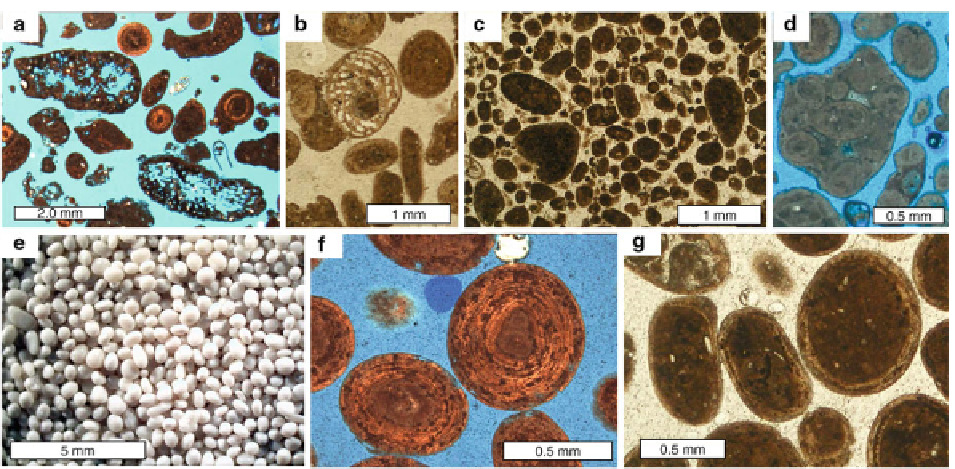Geology Reference
In-Depth Information
Fig. 20.2
Petrographic character of several types of sand pres-
ent in Bahamian tidal sand shoals. (
a
) Thin section photomicro-
graph of
Halimeda
fragments, such as those that can occur with
oolitic sand, Schooner Cays. (
b
) Thin section photomicrograph
of a peneropolid foraminifera, Lily Bank. (
c
) Thin section pho-
tomicrograph of poorly sorted peloidal sand, Lily Bank. (
d
) Thin
section photomicrograph of a composite grain made of numer-
ous ooids, Fish Cays. (
e
) Photograph of loose ooids with a pearly
luster from Lily Bank. (
f
) Thin section photomicrograph of
ooids with numerous laminations, Lily Bank. (
g
) Thin section
photomicrograph of superfi cial ooids with only one or two lami-
nae, Abaco tidal deltas
borings and binding from early cementation by fi brous
aragonite or encrusting by foraminifera or microbes
that collectively form aggregates with clumpy shapes.
The latter are essentially a sub-type of
composite
grains
(Newell et al.
1960
; “grapestone” of Illing
1954
), which can be formed of aggregations of peloids
or skeletal fragments as well as ooids, and which are
found in abundance in some shoals. Ooids commonly
are interpreted to represent direct physiochemical pre-
cipitates from seawater (Newell et al.
1960
; Bathurst
1975
; Deelman
1978
; Duguid et al.
2010
; compare
with Folk and Lynch
2001
), whose formation is favored
by: (a) water supersaturated with respect to calcium
carbonate; (b) a source of nuclei; and (c) a means of
agitation (e.g., Cayeux
1935
; Deelman
1978
; Davies
et al.
1978
; Sumner and Grotzinger
1993
; Reeder and
Rankey
2008
; Rankey and Reeder
2009
) . Ooids on
Bahamian platforms and Caicos are most abundant in
agitated waters less than 2 m deep (Newell et al.
1960
) ,
and most likely are formed there, although they can be
found in less abundance in deeper waters across parts
of some platforms.
In summary, many of the grains that form the tidal
sand shoals have a proximal source - they are formed on
or near the sand shoals themselves. Besides sediment
production on the sand shoals, another characteristic of
carbonate tidal sand shoals that is distinct from silici-
clastic tidal sands is the presence of early marine or
meteoric cementation.
Marine cementation
can be ubiquitous on sand
shoals, forming expansive
hardgrounds
, or early lith-
ifi ed surfaces (Fig.
20.3a
; Dravis
1979
) . Hardgrounds
are formed by fi brous acicular aragonite cements
(Fig.
20.3b-d
) or by fi lamentous algae that partly fi ll
intergranular pores and bind sediments (Hillgärtner
et al.
2001
). These marine cements can occur rapidly, in
periods of less than a year in some cases (Grammer
et al.
1999
). Many hardgrounds have sharp upper
surfaces that are extensively bored or encrusted, but
cementation intensity decreases downward, and they
grade to unconsolidated sands. Hardgrounds have several
important sedimentologic infl uences. First, because
they resist erosion more than unconsolidated sands,
they can armor surfaces from erosion. Second, they
form a substrate for colonization by organisms that
otherwise are not well suited to live on the shifting
sands of the tidal sand shoals, such as corals or sponges.
Finally, if eroded, these lithifi ed sediments can form
intraclasts
which can subsequently be transported as
sedimentary particles again.

